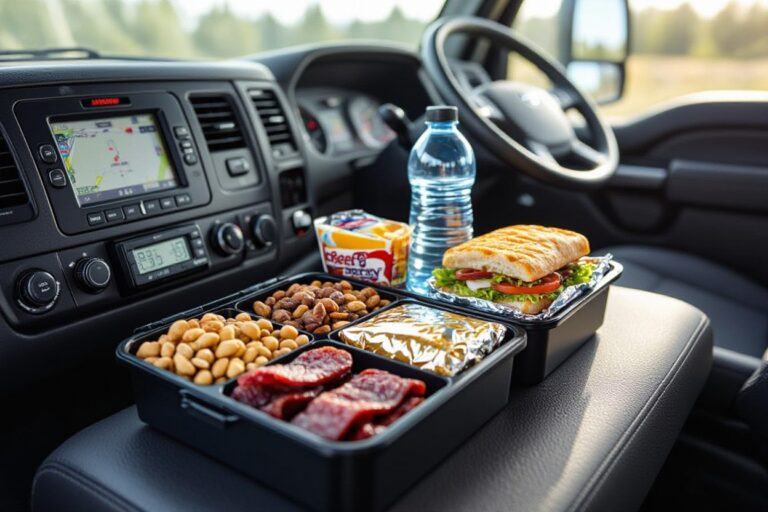
Paychecks take a hit when brokers skim loads, so you need direct-booking strategies and tight negotiation skills to protect your income. By cutting brokers, you can eliminate hidden fees, avoid scheduling bait-and-switches, and capture the full load rate—putting up to double your current take-home pay directly in your pocket when you optimize routes, fuel planning, and customer relationships.
Key Takeaways:
- Book loads directly with shippers to eliminate broker commissions and increase take-home pay.
- Negotiate clear rate confirmations and cultivate long-term shipper relationships for steadier, higher-paying lanes.
- Use load-matching tools, plan backhauls, and maintain proper insurance/compliance to maximize utilization and reduce empty miles.

The Broker’s Hidden Take: What You’re Really Paying For
Brokers rarely bill themselves as the expensive middleman, but you pay for more than matching loads: commissions, flat transaction fees, payment holds, and markup on accessorials. Typical brokered loads can shave off a noticeable slice of gross revenue through layered charges and slower payouts, turning a $3,000 invoice into significantly less cash in your pocket after commissions and fees are applied.
Understanding Broker Fees and Commissions
Brokers usually charge either a percentage or flat fee: industry norms sit around 10–20% commission, or $50–$300 per load on smaller moves. Additional charges—handling, fuel-surcharge retention, and administrative markups—add another $20–$150. Some digital brokers lower headline rates but recoup via faster payment programs and hidden add-ons, so you must audit contracts and settlement sheets to spot every deduction.
The Impact on Your Bottom Line
Each percentage point a broker takes cuts directly into your per-mile and per-trip margins; losing 15–20% to brokers can turn a healthy $3.50/mile load into sub-$3.00/mile net. Payment delays of 30–60 days force you into factoring or cash gaps, which adds extra costs and erodes working capital, making route selection and equipment upgrades harder to fund.
Example math: a $3,000 load with a 15% broker fee costs you $450, leaving $2,550. If accessorials or withholdings subtract $150 and you factor to avoid a 45-day wait at ~3% fee, another $72 disappears, delivering about $2,328 to you. On a 600-mile haul that’s roughly $3.88/mile net instead of $4.88/mile if you retained the broker cut—meaning thousands lost over a month of runs.

Direct Customer Relationships: The Key to Increased Earnings
Cultivating direct customer relationships cuts out broker fees (often 10–25% per load) and lets you negotiate stable, recurring lanes. You can lock in higher rates—many drivers report adding $0.10–$0.50 per mile—and secure guaranteed weekly minimums, improving cash flow and equipment utilization. Focus on a book of 5–10 consistent shippers to turn unpredictable loads into predictable revenue.
Building Trust and Loyalty with Clients
You hit on-time targets—aim for ≥98%—and send real-time GPS updates plus proof-of-delivery photos to reduce disputes. Offer straightforward Net-14 or Net-30 invoicing, a single point of contact, and a documented problem-resolution process; shippers you serve for 12+ months often shift from one-off loads to retainer-style agreements.
Strategies for Effective Direct Sales
You target 50 top shippers on your lanes using LinkedIn, trade shows, and local broker contacts; expect 5–15% conversion on well-crafted outreach. Pitch predictable weekly capacity, flexible pick-up windows, and a short trial lane; include a one-page capability sheet with insurance, equipment specs, and references to close deals faster.
Start with a one-page capability sheet, send 100 personalized emails monthly with 3 follow-ups, and track replies in a CRM; that cadence typically produces the stated 5–15% conversion. For pricing, calculate your direct cost per mile—if you run at $1.20/mile, proposing $1.60/mile yields roughly a 33% margin and is easier to sell when paired with guaranteed weekly capacity.
The Cost of Dependence: Risks of Relying on Brokers
Market Fluctuation Vulnerabilities
Brokers often shuffle you between contract and spot work, exposing you to volatile rate swings—spot rates can move 20–50% month-to-month during peak cycles. If brokers supply 60–80% of your loads, a 30% drop in spot pricing can wipe out margins overnight. You lose the ability to lock lanes, hedge capacity, or negotiate stabilizing terms that protect your cashflow.
The Erosion of Your Unique Selling Proposition
Brokers package you as anonymous capacity so shippers judge only price and ETA; your reliability, equipment specialty, or white-glove service rarely factor into the deal. That commoditization drives you into a race to the bottom, producing thinner margins and fewer repeat direct contracts even if your operational metrics outperform competitors.
Moving from 70% brokered loads to 30% brokered can boost direct-contract revenue by roughly 15–30% in many carrier case studies, since shippers pay premiums for demonstrated reliability. You can capture that upside by submitting targeted RFPs, offering dedicated-lane proposals, and backing claims with KPIs like 98% on-time delivery and POD evidence to reclaim pricing power.
Navigating the Transition: Shifting Towards Independent Work
Making the jump means sorting paperwork, insurance, sales, and cash flow. You need MC/DOT authority, tailored insurance, factoring or carrier lines to cover pay cycles, and a pitch for direct shippers. Operators who drop brokers often see 15–30% higher per-load revenue; owner-operators report converting spot-market broker business into steady direct lanes that stabilize weekly pay. Watch for underinsured loads and always verify contracts before onboarding new customers.
Essential Steps to Cut Out Brokers
Get your paperwork in order: file for MC/DOT, register for IRP/IFTA, and secure W-9s from customers. Lock in at least $750k primary liability and cargo limits your customers require, and set up factoring or a line of credit to cover 30–45 day receivables. Price by lane using fuel, deadhead, tolls, and a profit target (aim 20–25% margin). Build contracts with clear accessorials and load acceptance windows to avoid disputes.
Tools and Resources for Direct Transporters
Use a lean stack: a TMS with route-optimization, ELD telematics for hours and proof of service, EDI/API for invoicing, and factoring for cash flow. Expect TMS costs of $50–$500/month and factoring fees around 1–5%. Choose platforms that integrate, support PDF invoices, and offer automated POD capture to shave administrative time and reduce broker dependency.
Select a TMS that offers lane-level analytics and API access so you can price with data; you should be able to pull historical trip costs and get lane median rates. Integration between ELD and accounting can cut billing time by 75% in high-volume fleets; for small operators, automated invoicing can free up ~2 hours daily. Watch for hidden fees—transaction fees and EDI setup costs—and confirm 24/7 support if you’ll be chasing shippers across time zones.
Success Stories: Where Brokers Were Cut and Profits Soared
Several operators who sidestepped brokers saw dramatic gains: a solo owner in Texas grew net income from about $55,000 to $95,000 annually by sourcing direct shippers and marketing locally, a five-truck Ohio fleet boosted driver pay by 35% after eliminating average broker fees of 18% per load, and many reduced empty miles from ~20% to under 10% by controlling dispatch—showing how reclaiming freight margins directly lifts your bottom line.
Real-Life Examples of Independent Trucking Triumphs
Sara, an owner-operator in Florida, pushed per-mile take-home from $1.10 to $1.80 by signing three local shippers and cutting broker commissions; her annual net rose roughly $30,000. A Midwest regional carrier trimmed empty miles from 22% to 10%, dropped turnover by 15%, and improved weekly utilization from 47 to 56 hours by scheduling direct lanes and offering stable weekly routes to drivers.
Lessons Learned from Broker-Free Operators
You must learn to prospect persistently: target 10–15 shippers, offer volume discounts, and set a minimum accepted rate to avoid race-to-the-bottom loads. Many operators found investing $2,000–$5,000 in a lightweight CRM and driver route planning cut admin time by half and preserved margins while keeping capacity booked.
Operational rules that paid off: insist on 48–72 hour payment terms with penalties, negotiate contract lengths of 6–12 months for lane stability, and build a backup plan using national load boards for off-peak fill. You should track deadhead miles and fuel surcharge recovery meticulously—operators who did saw per-trip profit rise by an average of 20–30%.
Conclusion
Taking this into account, cutting out brokers lets you negotiate rates directly, capture full load revenue, and build direct shipper relationships that increase efficiency and margins; by investing in load boards, route planning, and strong contracts you gain control over pricing, reduce fees, and can realistically double your paychecks as your operating leverage improves and your fleet becomes more profitable.
FAQ
Q: How do brokers lower what drivers or owner-operators actually take home, and how can cutting them out increase pay?
A: Brokers typically mark up freight by 10–30% and keep the difference between what the shipper pays and what the carrier receives. That markup reduces the pool available for driver pay or owner-operator margin. Example: a $2,000 load with a 20% broker fee nets the broker $400; the carrier and driver split the remaining $1,600. An owner-operator who books that same load directly keeps the full $2,000 (minus fuel, tolls, and operating expenses), which can translate to two or more times the driver take-home compared with carrier-split models. To realize higher net pay you must: build direct shipper relationships, price loads to cover cost-per-mile plus margin, and invoice/collect directly so fewer middlemen take a cut.
Q: What practical steps let drivers or small carriers find and win direct freight without brokers?
A: Target shippers in your lanes, use cold outreach and networking (email, phone, LinkedIn), attend local trade shows, and join regional logistics groups. Offer reliability proofs: carrier packet, insurance COI, references, fleet photos, and on-time statistics. Propose simple, transparent terms (rate per mile, fuel surcharge, detention, layover, accessorials) and offer capacity guarantees or trial runs to build trust. Use a short service contract or signed rate confirmation to lock terms. Price competitively by calculating your true cost-per-mile (fuel, maintenance, insurance, driver pay, overhead) and add the margin you need—don’t underprice to chase volume.
Q: What are the main risks of cutting out brokers and how do you mitigate them to protect income stability?
A: Risks include inconsistent load flow, slower cash collection, administrative burden (billing, compliance), and needing to shoulder backhaul/empty miles. Mitigate by diversifying a shipper base across lanes, requiring clear payment terms and credit checks, using simple contracts and rate confirmations, and keeping a 30–60 day working capital reserve. Consider partial use of factoring for cash flow (weigh fees vs. benefit), build predictable lanes or dedicated routes, set minimums for deadhead and detention, and track cost-per-mile continuously so rates cover variable and fixed costs plus desired profit. Strong operational discipline and basic sales processes reduce volatility and preserve higher net pay.




